|
Right, here we go...
When I began researching Inseminoid, one thing became abundantly clear; it definitely wasn't influenced by Alien. No sir, not a bit. On one of the special features on this disc, producer Richard Gordon is emphatic that none of those involved in the making of Inseminoid had seen Ridley Scott's sf-horror masterpiece when they made their film. They couldn't have, he assures us, as Alien hadn't even been released when they started shooting. Hmm. It may well be the case that the husband-and-wife team of Nick and Gloria Maley wrote their screenplay before clapping eyes on Ridley Scott's masterpiece, but research suggests that Alien hit UK cinemas a good eight months before principal photography on Inseminoid commenced and US cinemas four months before that. In case you need reminding, Norman J. Warren was and remains a fan of horror movies and Alien was a blockbuster hit that every genre fan worth his or her salt rushed to the cinema to see as soon as they were able. I'm just saying...
What I will say is that Inseminoid is not the cheapjack Alien rip-off that some accused it of being on its release, but the idea that it wasn't in any way influenced by Scott's film cuts little ice with me. It wasn't, I should point out, an isolated case, and that's hardly surprising. Alien redefined the look of cinematic space travel, and the gender-mix of its crew and the unglamorous practicality of its ship interior quickly became new the new genre norm. It's success also saw Hollywood studios try to cash in on its success with titles like Saturn 3 (1980) and Outland (1981), while flying the flag for the independents, as ever, was New World with the 1981 Galaxy of Terror, and the cheapie 1980 Italian rip-off Alien 2: On Earth.
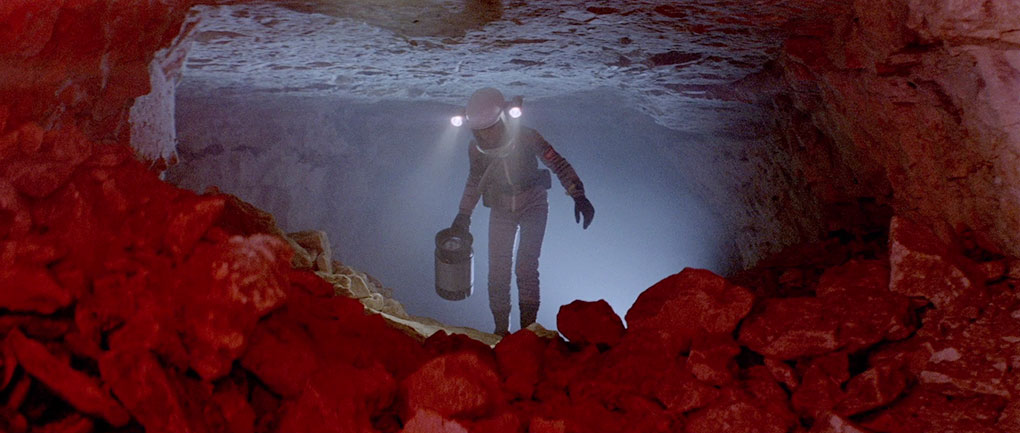
As with Alien, Inseminoid features a mixed-gender crew stationed in the isolation of deep space. Here they're not on a spaceship but on an unspecified planet where they've been tasked with the excavation of ruins of an ancient alien civilisation. According to Warren the original plan was indeed to set the film on a spaceship but it would have cost too much to design and build the sets. Instead they secured full access to the Chislehurst Caves in Kent, which double rather nicely as underground mining tunnels. Anyway, whilst prodding around the caves in a sequence that visually takes its cue from the exploration of the alien ship in, erm, Alien, crew member Dean (Dominic Jephcott) discovers a cocoon that then explodes in his face and knocks him cold. When his crewmates get him back to their base, Doctor Karl (Barry Houghton) notices that he is clutching a handful of crystals and sensibly puts them in a jar rather for later study. These same crystals then infect fellow crew member Ricky (David Baxt) through a wound in his arm, prompting him to go batty and charge back into the caves. On his way he pushes Gail (Rosalind Lloyd) out of his way, causing her to fall on some debris and wedge her foot between two twisted metal shards on the floor. It's a predicament that from where I was sitting looks as though she could easily escape from if she just stood up and leant forward, but oh no, she's trapped, her thermostat is failing and she's a bit of a panic monkey. So instead of listening to radioed advice from her colleagues, she opens her helmet, stuffs the air feed from her backpack into her mouth and tries to cut her foot off with a futuristic chainsaw, one that looks suspiciously like a hedge trimmer and that couldn't make a serious dent on a piece of puff pastry. Kate (Stephanie Beacham), who I initially thought was a reporter and turned out to be the mission's Documentation Officer, whatever that is, puts a sharp end to Ricky's rampage by shooting him squarely in the chest with a spear gun.
Once Gail and Ricky have been safely buried on the planet's surface, Sandy (Judy Geeson) and archaeological boffin Mitch (Trevor Thomas) return to the caves to collect some more of those crystals. The same crystals that infected Ricky and drove him mad. Their mission goes awry when a large alien creature appears out of nowhere and disposes of Mitch. It then takes Sandy prisoner and, in a scene that should have you shifting in your seat in discomfort, impregnates her with a gooey fluid pumped through a glass tube that is inserted into her...well...I'm sure you don't need me to spell this one out. A search party brings the disorientated Sandy back to the base, and as an alien creature starts growing speedily inside her it begins to take control of her actions and turn her against her surviving colleagues, whom she sets about killing one by one. To recap, a human astronaut is attacked by an alien creature, one that plants its seed inside its human victim who is then transported back to the base by two comrades, where the seed enters the human habitat inside of the body of its victim, where it grows until ready to be born and it tries to kill all of its victim's crewmates. Now where, exactly, have I heard that before?

So is Inseminoid science fiction, horror or a slasher flick? Yes, yes and yes. Unlike those earlier Warren movies that I so recently fell for, this film is not remotely interested in low key naturalism or the notion of slow build (two things that continue to make Alien special, by the way) and opts instead to start the action early and then just keep it coming. And I've no problem with that. What trips it up a little are a handful of iffy performances, a lack of character depth, and the fact that much of the action is, well, not all that great. There's a lot of running about and chasing and bashing into things and pushing people over, but...
OK, considering I responded so well to previous titles in this set and am by nature sympathetic to the specific pleasures of low-budget genre filmmaking, why is it that much of Inseminoid still fails to click for me? This is, after all, something of a favourite with those who cherish Warren as a director. What am I not getting? Certainly the fact that some of the sets and technology have a future-on-the-cheap feel is not a problem. It's a common trait of low and even medium (and occasionally high) budget sf films whose predictions are based on then current trends and fashions and are often more about looking sleek and minimalist than creating environments that people would realistically choose to live and work in. And when you're doing things on the cheap you have to fake it as best you can with whatever comes to hand. But we've learned to live with that, at least if there are appropriately mitigating factors. Dark Star, anyone? Where Warren aims high but almost inevitably stumbles is in the conflicting demands here of pace and characterisation. In an approach that's almost the polar opposite of the one taken in Satan's Skin, in this film things kick off even before we've seen any of the characters without their spacesuits. The problem for audience identification is that there are a hefty twelve people on this mining station, and if we're going to care about what happens to them we need to get to know a little about them before horrible things are inflicted on them. The short version is we don't. Maybe if they'd each had a distinctive introduction, just a spattering of witty or engaging dialogue, a memorable trait, or a short sequence telling us something about them beyond the news that X is having an affair with Y it would have helped. But the truth is that I had to watch the film a third time with a notebook in hand and then reference the film's Wikipedia page to even put names to some of the faces, faces that I still can't easily recall. Once again, Alien provided an object lesson in how to do this, as did John Carpenter's The Thing the following year. What's a tad frustrating about all of this is that Warren did a blinding job of it himself in Prey, where we spent a lot more time with considerably fewer people and thus got to know them rather well before the story got under way. Even the incident-packed Terror had more distinctive and well-rounded characters than present here. In Inseminoid, the only ones who really stood out for me were the doctor (interesting face) and the unfortunate Sandy, at least once she moves out of the ensemble to become the main antagonist.
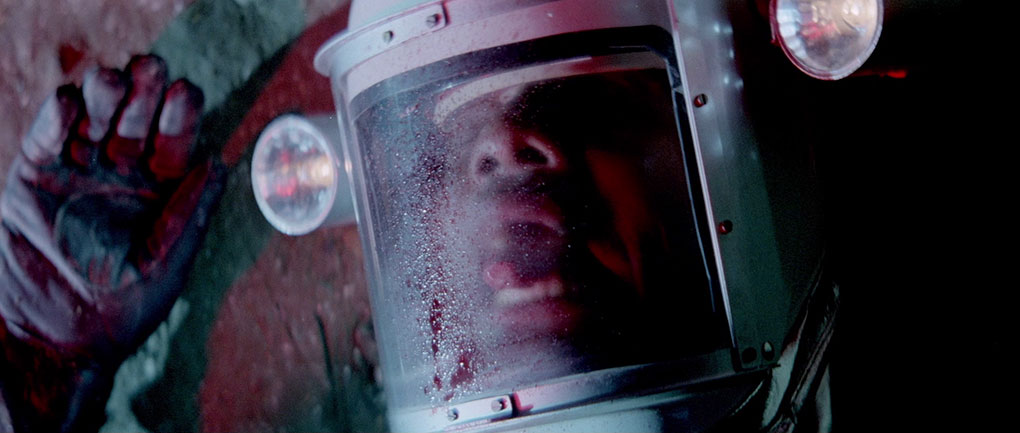
Being a Norman J. Warren film, we expect there to be violence and while the gore makeup is as good as ever, some of the physical conflict is oddly toothless here. When the rampaging Sandy bangs one of her victims' head against a cupboard hard enough to spray blood, you can see her doing the head-bash equivalent of pulling her punches to avoid causing actual injury to the actor. Elsewhere there's a similar lack of force to hits and throws that are supposed to be indicative of the strength of the aggressor in question. Neither the hedge trimmer chainsaw or the welding gun make for particularly fearsome weapons, especially as the welding gun is used to kill by advancing slooooowly towards the verbally protesting victim and snapping the sparky pincers open and closed for the camera. I'm also still trying to work out why an archaeological team would feel the need to include a spear gun on their list of essential equipment. Probably for the same reason the crew of the Nostromo thought it prudent of add a grappling hook gun to theirs.
So am I as dismissive of the film as I was when I first saw it? Well, despite everything I've written above, I'd have to say no. I was younger and less tolerant then and less receptive to what makes horror and science fiction so ripe for more analytical study, and there's definitely some subtextual meat to get your teeth into here. Central to this is the character of Sandy and the unspoken notion that the alien DNA that has invaded her system is tapping into and firing up her maternal instinct to protect the life form growing rapidly inside her. It drives her to remove all potential threats to its survival, and if that means disposing of her former friends and colleagues, then so be it. And once she starts taking them out she's given good reason to get pissed at the survivors when one of the men foils her attack on a female colleague by heavily pressing his foot on her pregnant belly and then angrily stamping on it for good measure. Having genuinely winced at this action myself, I was not surprised when Warren revealed in the extras that this moment had women's groups up in arms on the film's release. What really sells this aspect of the film is the total commitment of Judy Geeson's performance as Sandy. Her physicality and focused fury makes her a convincingly dangerous threat and I absolutely bought into the notion that she could beat seven bells of crap out of even the toughest of her former comrades. The sheer wincing intensity of her pained screams as she gives birth to her alien progeny, meanwhile, should be enough to convince a few of those watching that the so-called miracle of childbirth is possibly not all it's cracked up to be.
Warren's regular composer John Scott opted for an electronic score here, and while I have to admit that there are times when it made my fillings hurt, there are also moments when it proves unexpectedly effective and some elements even have the ring of late-career John Carpenter about them. Not bad for film that was released the same year as Escape From New York. I also really like the cave set that's lit primarily by lights in the floor panels, a familiar bit of sf movie design that was doubtless done on the cheap but looks as good as any of its big budget counterparts. Warren's ever-inventive regular art director Hayden Pearce really earned his (probably deferred) wage on this one.
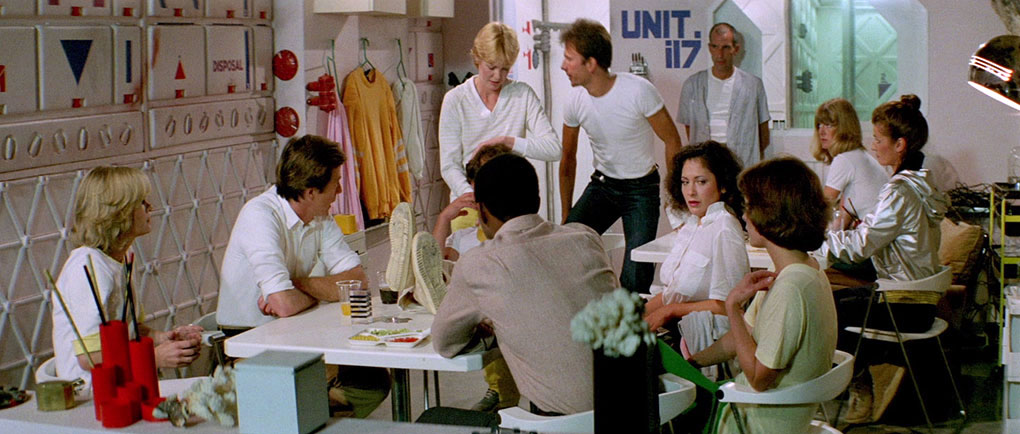
So did this turn me all around on Inseminoid? Well, yes and no. As I watched it again (and a third time) it felt almost as if the things I didn't like were doing battle with the ones that I have subsequently warmed to, and while the former ultimately won the battle it was a closer fight than I could have expected. Just recently I read an interview with Martin Scorsese in which he said, "The films that I constantly revisited or saw repeatedly held up longer for me over the years not because of plot but because of character,"* and I can't fault him on that. Despite the attention that is always paid to its makeup effects, I'd ague that a key reason The Thing is so riveting and so tense is that each of its characters is so distinctively drawn before any of them falls victim to the monster in their midst. For me, it's the lack of character depth, coupled with some unexciting performances, dialogue that never rise above the functional and the decision to kick things off before we've really got our bearings that makes it hard to care anything like as much about the death of any of the Inseminoid crew. Ultimately it's in Sandy and her protective maternal rampage that the film is at its strongest and most subtextually interesting, though a perhaps unintended side-effect of this is that I found myself siding with her as she stalked the surviving members of her team, much as I might with Jason Voorhees as he disposes of charisma-free teens in one of the Friday the 13th films. Yet I can't fault its drive or its energy, and despite the (probable) Alien influence it still manages to be unexpectedly forward-looking, with a final scene that contains elements and imagery that absolutely anticipates the content and look of a key sequence from Aliens, which at the time of filming was a good five years in the future.
Whatever your views on the film you should be more than happy with the 2.35:1 transfer here, which was scanned and restored in 2K from the original internegative by Screenbound Productions under Norman J. Warren's supervision and looks terrific. The detail is sharp, the contrast just right and the colour vibrant without feeling artificially saturated. It's clean and stable and has a very fine film grain, and is quite possibly the best restoration in the set.
The Linear PCM 1.0 mono soundtrack is also in good condition. The bass notes may not boom and rumble but at least there is some bass. There's also none of the crispy trebles you'll find elsewhere in this set. The dialogue is always clear and the music especially so.
Optional English subtitles for the hearing impaired have been included.
Audio Commentary with Norman J. Warren and Gary White
Here Warren is teamed with the film's first assistant director Gary White, who was present for all of the film's principal photography and at the time of recording was still good friends with the director. As ever, Warren is a fountain of memories about the making of the film, and much of what he has to say you'll be hearing for the first time here, at least if you're watching the special features in the order they're listed on the discs and in these reviews. We learn that the abstract opening title backgrounds were done by Oxford Scientific Films, that the planet surface exteriors were shot on the island of Gozo, that a number of the cast suffered injuries on the shoot, that one oddly high-angle shot was the result of the production running out of money, that Warren struggled to get much of a performance out of Victoria Tennant, and that the futuristic chainsaw was indeed the hedge trimmer it looks to be. We're provided with the formula used to create the gooey alien sperm (now you can make your own!), and in a lovely bit of gotcha timing, Warren remarks on what a shame it wa that at the end of Alien we could see that the title creature was a man in an alien costume just seconds before his own, even more obviously man-in-an-alien-suit creature puts in an appearance. As ever, there's loads more, and Warren is as engagingly chatty as ever.
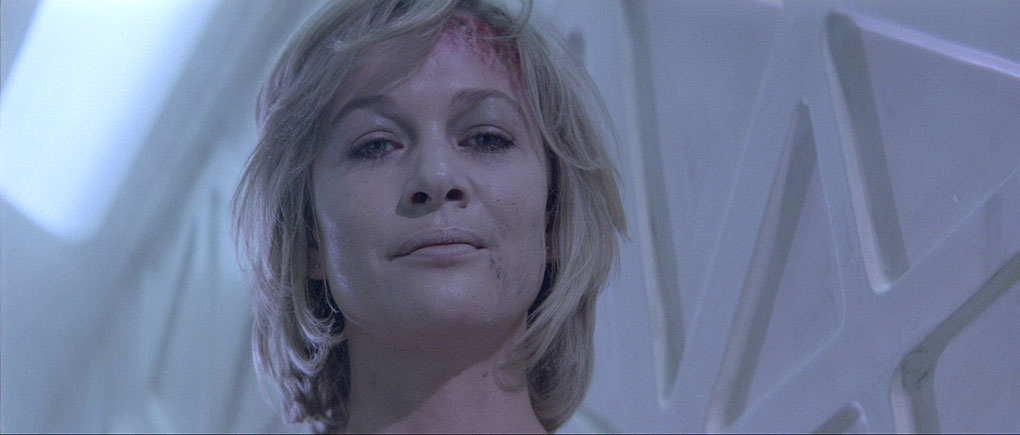
BEHP Interview with Norman J. Warren Part Two (69:20)
The second part of the British Entertainment History Project interview with Warren (the first is on the Prey disc) focuses on his film career from 1976 through to 2018, and thus covers the inception and production of all five films in this box set. A lot – though not all – of what he has to say about them you will also find covered elsewhere in this set, but if you're looking for a comprehensive overview of all of them then this is the interview I'd plump for first. In addition, we also get info and anecdotes about the making of the 1979 sf comedy Spaced Out, which gets hardly any coverage elsewhere, plus a documentary film he made for pop star Gary Numan and his recent collaboration with filmmaker Yixi Sun, Susu. That last one is covered in more detail on the Bloody New Year disc.
Manchester Festival of Fantastic Films Interview (61:30)
Recorded at the Manchester Conference Centre at the event named in the title, this has Warren interviewed on stage by an initially very animated and enthusiastic John Llewellyn Probert. He opens with the stated intent of conducting this as an informal chat instead of the career overview that other interviews with the director tend to consist of. It doesn't quite work out, but we still get to hear a great deal here that gets only a passing mention in other extras in this set. The centrepiece has to be the problems that Warren had with producer Maxine Julius on the 1986 Gunpowder and on Bloody New Year, which is a welcome expansion on the coverage he gives this in the BEHP interview detailed above. He's impressively and entertainingly forthright about the things that went wrong on these films and why. This includes the hiring of what he describes as the world's worst stunt driver and equally terrible explosives and gun specialists, whose combined ineptitude nearly resulted in the deaths of cast and crew members. The stories about Julius's late-night drinking and how they would find her in the morning sleeping on public benches and how this repeatedly put the filming of Gunpower behind schedule makes it all the more surprising that Warren risked working with her again on Bloody New Year. She apparently convinced him that she'd changed her ways. Want to guess how that worked out? In a particularly telling moment when talking about Gunpowder, Probert asks Warren, "Are there any bits or effects you are happy with?" to which Warren replies instantly, "Not really." The sound is recorded with an on-camera mic and is clear enough, but Warren does occasionally forget to hold his microphone – which is hooked up to the venue's PA system – up to his mouth and his voice can thus be a little quiet in places. This is such valuable inclusion that I'd live with it.
Subterranean Universe (44:46)
A making-of featurette produced for what I'm guessing is an earlier DVD release, one whose unattractive lighting camerawork thankfully does not detract from the content, some of which is unique to this extra. Those interviewed include Warren, producer Richard Gordon, executive producer Peter M. Schlesinger, art director Hayden Pearce, first assistant director Gary White (it's he who shares the commentary track with Warren), composer John Scott, and actors David Baxt, Barry Houghton and Stephanie Beacham, who still has a voice that could prompt even hardened career criminals to melt at her feet. Warren associate Ken Dowling also pops up near the end to talk briefly about a promotional flyer that he and Warren produced that caused offence and was subsequently judged by both men to have been a bad call. There's plenty of interest here and even familiar stories are refreshed by being told from an alternate perspective, and while he recalls that the film was generally well received, Warren does remember a BAFTA screening at which elderly industry figures were disgusted by it in a manner that only helped to sell the film to its target audience. In my favourite throwaway moment, Warren recalls that Stephanie Beacham was a joy to work with but kept calling the film 'Insecticide'.
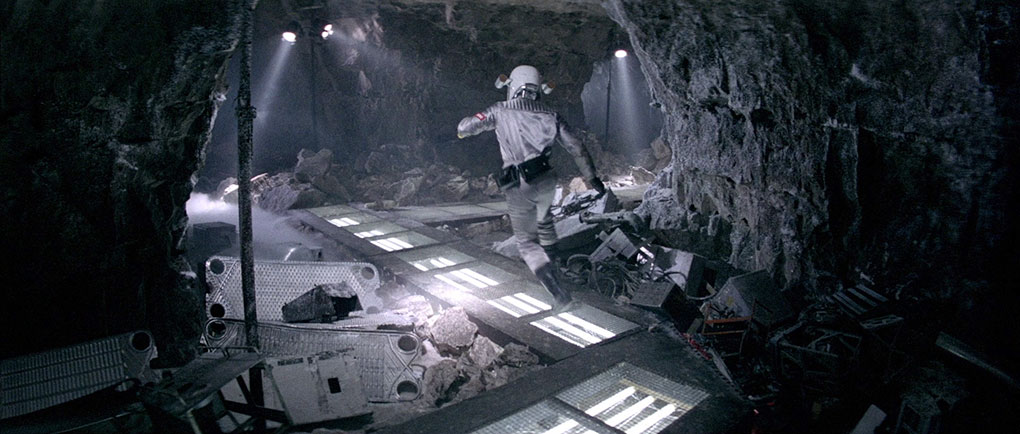
Alien Encounter (6:02)
A brief chat with actor Trevor Thomas, who remembers working with "a lot of pretty ladies" but otherwise divides his time between cheerful chuckles and lightweight snippets of answers to unheard questions. Interestingly, he does at one point describe the film as "a cross between Alien and Rosemary's Baby."
Electronic Approach (13:10)
Composer John Scott talks about the partially budget-driven decision to go with an electronic score, though he compositionally approached it as a "synthetically produced" orchestral one. He also talks about the soundtrack album and one element of the closing music that didn't make it into the film.
Trailers and TV Spot
The Theatrical Trailer #1 (2:13) is not a bad sell, despite its overly serious dramatic narration and is better than Theatrical Trailer #2 (1:47), where some of the film's weaker elements are on show. This one's definitely not for kiddies, and the audio quality of the narration takes a serious dive midway and then recovers, suggesting a restoration from two sources. Theatrical Trailer #3 (1:02) is a short version of #2 and includes the line, "The most dreaded fear of every woman on earth is even more horrifying in space – the inconceivable is about to be conceived." A jelly baby for whoever came up with that one. The French Theatrical Trailer (2:28) is a French language take on #1, and the 'Horror Planet' Teaser Trailer (0:31) is for the film under its US retitle, one that assures us that, "No-one who lands here leaves here alive." Does that count as a spoiler? You'll have to watch the film and see. Finally, we have a TV Spot (0:31), which is a shorter take on the structure followed by its theatrical brethren.
Image Gallery
A hefty 108 screens of promotional and production stills, including that image from the VHS cover (three times), press book pages, video covers (including the one I referred to in my introduction to this set) and posters.
< previous | Satan's Slave | Prey | Terror | Bloody New Year | next >
|